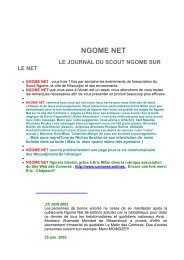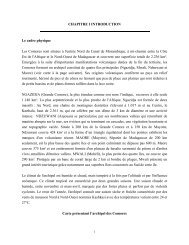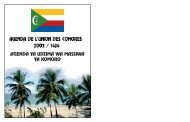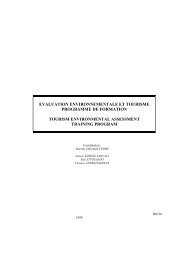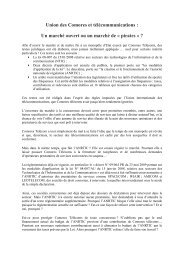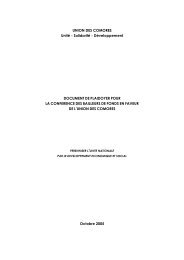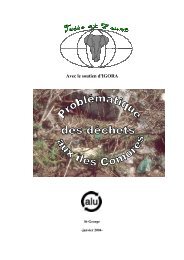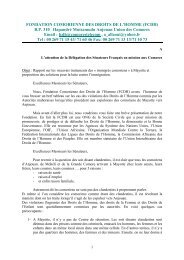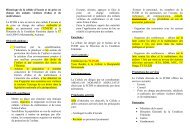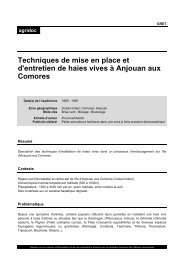Guide économique des Comores au format .pdf - Présidence de l ...
Guide économique des Comores au format .pdf - Présidence de l ...
Guide économique des Comores au format .pdf - Présidence de l ...
- No tags were found...
You also want an ePaper? Increase the reach of your titles
YUMPU automatically turns print PDFs into web optimized ePapers that Google loves.
Union <strong><strong>de</strong>s</strong> <strong>Comores</strong> 2003Regional cooperation<strong>Gui<strong>de</strong></strong> économiqueSectoral datas6The Comoros has initiated a process for regional economicintegration since 1986, with the countries of Eastand Southern Africa and the Indian Ocean. To date, theComoros is a member of three sub-regional groupingsworking towards establishing a harmonised legal, financialand economic environment within the involvedcountries, in view of promoting our potentials on the globalmarkets.The indian ocean commissionThe Comoros became member of the Indian OceanCommission (IOC) in 1986, a commission uniting fivecountries from the sub-region: Madagascar, M<strong>au</strong>ritius,Reunion, Seychelles, Comoros, through a regionalcooperation agreement.The Comoros took part in the regional programme onthe <strong>de</strong>velopment of exchanges (PRIDE) and took alsopart in all the festivities organised for this end, namelyprofessional shows and fairs organised in the region.h A standard and quality service was set up in theMinistry of Industry with the support of the projectPRIDE.h The Comoros took part in the regional programme onthe Environment and for the <strong>de</strong>velopment of Tourism.The common market for eastern and southernafricag The Comoros has contributed to the setting-up of theCommon Market for Eastern and Southern Africa,COMESA, which has taken over the initial entity, thePreferential Exchange Zone (ZEP). The country alsosigned the COMESA Treaty in 1994.g The country subscribed to all the COMESA programmespertaining to the harmonisation of monetary policies,such as the setting-up of a payment and settlingCOMESA system, which will favour the reduction oftra<strong>de</strong> transaction costs and the risks inherent to theconvertibility, the creation of a SWIFT office for safetransactions and the project for the facilitation of regionalcommerce (PFCR).g The Comoros took part in the forum for the facilitationof Regional Integration in favour of the free movementof goods, people and money, in East and SouthernAfrica and in the Indian Ocean.Importance of the agri business sectorThe contribution of the agriculture in the economy ofthe Comoros is significant in terms of the <strong>format</strong>ion ofthe GDP, employment and satisfaction of the basicneeds for food, exports and revenues. It provi<strong><strong>de</strong>s</strong>about 4% of the GDP, 80% of the employment andclose to 90% of the revenues.h Alimentation farming constitues about 47% of thetotal value of the agricultural sector.h Fishing constitutes about 21%h Commercial farming 13%h Breeding 8%h Inter island transportation is provi<strong>de</strong>d by 23 mediumsized boats with a 25 ton capacity.Opportunities in the agri businessThe principal opportunities are as follow:h The climate is tropical and humid, influenced mainlyby the altitu<strong>de</strong> and the ocean. The amount of rain variesbetween 1600mm and 2700mm a year. Precipitationsoccured all year round.h The difference in agriculture products prices betweenthe islands favorise the tra<strong>de</strong> and specialisation of theagriculture on each island. With no tra<strong>de</strong> barriers, thisshould benefit the consumers.h The country has an operational agriculture strategy.h We count between 40,000 and 50,000 farms: about60% in Ngazidja, 35% in Ndzuwani, and 5% in Mwali.g Commercial Farming:Commercial farming (vanilla, clove, ylang ulang) generatesabout 98% of the total value of the Comorrosexports. Production is subject to fluctuation from year toyear. It is <strong>de</strong>pen<strong>de</strong>nt on production techniques as wellas world prices. This has important repercussions on theexport revenues, tra<strong>de</strong> balances and producers incomes.g Maket gar<strong>de</strong>n farming:Market farm products were <strong>de</strong>veloped very quicklyduring the last few years and are almost exclusively soldto urban markets. This sector has benefited from theadditional attention paid to production techniques sincethis sector provi<strong><strong>de</strong>s</strong> significant income for the producers.



